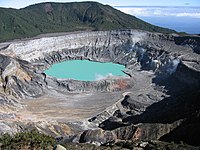Strongest earthquake in 150 years hits Costa Rica
Saturday, January 10, 2009

The United States Geological Survey said a 6.1 Mw earthquake struck on Thursday, at 01:21:34 p.m. local time (6:21:34 p.m. UTC) in northern Costa Rica, a Central American country, 30 kilometres (19 mi) NNW of San José and near the volcano Poás.
The epicenter was at 20 miles (32 kilometers) north-northwest of San Jose at a depth of 2.8 miles (4.5 kilometers), with Coordinate 10° 11′ 49.2″ N, 84° 9′ 32.4″ W, and Decimal 10.197,-84.159. Causing widespread panic and damage, it was felt all over Costa Rica as well as in southern central Nicaragua, and was the strongest to shake Costa Rica in about 150 years.

“Today is a day of mourning for Costa Ricans,” President Oscar Arias Sanchez said. “These losses of life fill us with pain; our prayers will be for their families, hundreds of families had seen serious damage to their homes,” Arias added. Originally seventeen people, including three children, were reported killed but was later decreased to 5 fatalities. About 42 were reported missing, at least 32 were injured and 2,450 people affected.
The quake toll jumped to 34 dead, 64 missing, on Saturday, while emergency workers rescued at least 200 stranded tourists in Varablanca hotel, according to Ministry of Infrastructure spokeswoman Silvia Chaves.
Amid problems of mudslides, cracked roads, tumbling rocks and fallen trees, National Social Security and Health agency, Red Cross rescue workers, firemen and police rushed Friday to evacuate about 600 people. Half of them were foreign tourists stranded in La Paz Waterfall Gardens eco-resort in Vara Blanca, and others were trapped by boulders and earth, when mountain roads in Costa Rica blocked two villages of Vara Blanca and Cinchona. The main CNE warehouse containing relief items (food, mattresses), for distribution to the victims, was burned, while the second airport in San Jose, is now closed.
Most of the victims died when part of the hillside collapsed and a landslide occurred near the La Paz waterfall at Vara Blanca, on the flanks of the volcano Poás. The Poas Volcano National Park was utterly destroyed and the La Paz waterfall road was torn, causing about 300 tourists trapped. At least 400 people were evacuated from the area in rescue helicopters.
Constant 2,000 aftershocks (1,200 through early Friday in the towns of San Pedro de Poas and Vara Blanca), complicated the rescue and emergency missions for stranded people in mountainous central zones. National Emergency Commission official Victor Falla said that there were small tremors every couple of minutes. "It's shaking right now," he added. 1,244 people were displaced, and 1,078 people are living in shelters. In addition, a hotel, houses, roads, and vehicles were damaged, and a couple of bridges were destroyed. The town of Cinchona was heavily hit, and all of the buildings there were heavily damaged. Power was temporarily disrupted in San José. "There are many buses and many vehicles that are trapped," deputy public safety minister Jose Torres said.

In the central valley, populated by 2.5 million of the country's four million inhabitants, the National Emergency Board declared an emergency in the metropolitan area including San Jose, Cartago, Alajuela and Heredia. The earthquake hit strongest the remote area near Alajuela. Several homes collapsed and major highways were still blocked.
A team of 34 U.S. military personnel and four Black Hawk helicopters from Honduras-based Joint Task Force-Bravo was sent on Friday by the U.S. Government to assist Costa Rican rescue workers, which include 400 volunteers and Red Cross personnel, who were dispensing aid in 15 communities. Colombia and China had also offered assistance to quake victims. The U.S. Army and Air Force aviation crews, rescue, medical and support personnel, is coordinating with the Office of U.S. Foreign Disaster Assistance (OFDA) in the rescue efforts. At least 150 stranded tourists from the United States, France, Canada and Spain, were finally rescued on Friday.
Related news
- "Indonesia hit by 6.1 magnitude earthquake" — Wikinews, May 19, 2006
Sister links
Sources
- "34 dead, dozens missing from Costa Rica quake" — CNN, January 11, 2009
- "Death toll rises to 15 after Costa Rica quake, dozens still missing" — Agence France-Presse, January 10, 2009
- "14 killed in strong Costa Rica quake; hundreds trapped" — The China Post, January 10, 2009
- "Costa Rica earthquake death toll rises to 15" — CNN, January 10, 2009
- Blake Schmidt. "Costa Rica: Quake Kills at Least 15" — New York Times, January 9, 2009
- Joint Task Force - Bravo. "U.S. Southern Command Deploys Disaster Response Team to Costa Rica" — DVIDS News, January 9, 2009
- United Nations Office for the Coordination of Humanitarian Affairs (OCHA). "Daily Note on Emergencies: Costa Rica 6.1 Earthquake Issue 1" — Relief Web, January 9, 2009
- Roger Benavides. "Tourists evacuated after fatal Costa Rica quake" — Reuters, January 9, 2009
- "Death Toll From Costa Rica Earthquake Climbs to 14" — Latin American Herald Tribune, January 9, 2009
- AFP. "Red Cross revises death toll in Costa Rica quake" — ABC News (Australia), January 9, 2009
- "2009_Costa_Rica_earthquake" — Map sources/GeoHack, January 9, 2009
- "Magnitude 6.1 - COSTA RICA" — USGC, January 8, 2009


